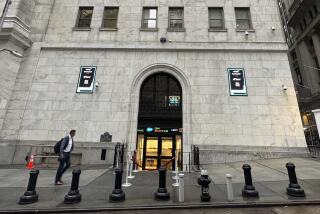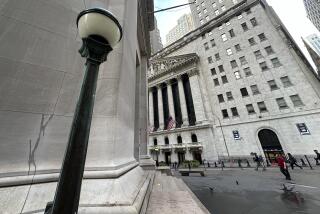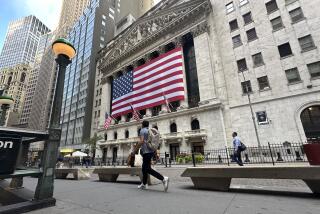Despite Caution Signs, Market Stirs High Hopes
At first glance, the soaring bull market seems like itâs due for a fall. Various measures of stock values are dangerously near levels that signaled market tops in the past.
But relying solely on these measures may be deceiving, many experts say. Several factors that have propelled stocks to record highs--low inflation, low interest rates, corporate restructurings, fast money growth and high foreign buying--persist and could easily keep the good times rolling for several months or longer, they say.
âI canât recall a previous period when all these things were going on at one time,â George K. Dorian, technical analyst at Wedbush Securities in Los Angeles, said of the combination of bullish conditions.
If the bull market continues, it would prolong a market rise that already has astounded most analysts for its ability to defy most precedents. The Dow Jones index of 30 industrial stocks, at a record 2,280.23, has nearly tripled since the bull market began in August, 1982--a run-up unparalled in speed since the roaring 1920s.
The list of market leaders--dominated earlier in the bull market by the blue-chip stocks of the Dow industrial average--now includes a broader cross-section of issues. Broader market indexes, such as Standard & Poorâs 500 stock composite index, the American Stock Exchange market value index and the NASDAQ composite index of over-the-counter stocks, have all joined the Dow industrial index in setting record highs in recent weeks.
Such major advances have pushed three widely watched stock indicators--price-earnings ratios, dividend yields and the ratio of stock prices to book value--close to levels that historically have preceded bear markets. Accordingly, some market analysts worry that a correction of 10% or more--which could shave more than 200 points off the Dow index--could interrupt or end the current bull market.
Price-earnings ratios, which measure the price of a stock divided by its earnings per share, are now averaging about 18, more than double the level four years ago and near the 20-plus range that has preceded major bull market tops in 1962, 1966, 1969 and 1972, said Norman G. Fosback, editor of Market Logic, a Fort Lauderdale, Fla., newsletter.
But price-earnings ratios based on last yearâs fourth quarter results may be inflated somewhat. That is because many companies took writeoffs in that quarter, due to the repeal of the investment tax credit or other changes under tax reform, said David Blitzer, chief economist for Standard & Poorâs. With those factored in, the ratio for the S&P; 500 might be 16.5 or 17 instead of 18, he said.
The price-earnings ratio also may be overstated because corporate earnings are expected to surge this year, thanks to restructuring, shedding of unprofitable assets, layoffs and other cost-cutting moves. Blitzer, for example, expects per-share earnings of companies in the S&P; 500 to rise 23% this year (more optimistic than the consensus of other economists), which would cut the price-earnings ratio of the index to a more comfortable 14.7.
Current low dividend yields also are misleading, some analysts say. Dividend yields--annual dividends as a percentage of stock prices--now are at 2.96% for the stocks in the S&P; 500, Fosback said. Thatâs the first time they have fallen below 3% since July, 1973, he said. Yields below 3% also preceded market tops in the last three decades, he said.
But instead of boosting dividends, many companies have bought back stock, which really is just another form of dividend in that it raises share prices, said Elaine M. Garzarelli, chief quantitative analyst at Shearson Lehman Bros. in New York. International Business Machines and General Motors Corp. are among the most noteworthy of firms recently announcing plans to buy back stock. Other companies, such as ITT Corp., are studying it.
Also, low dividend yields may not last long. Reduced individual tax rates under tax reform, which make dividends relatively more attractive, are spurring more companies to boost dividends, reversing a trend of recent months, said Arnold Kaufman, editor of Standard & Poorâs Outlook newsletter.
Companies now also have the earnings power to be more generous with their dividends, Tracy G. Herrick, an economist for Jefferies & Co., a Los Angeles brokerage, contended. âTrueâ corporate earnings, which include depreciation allowances in excess of the actual wearing out of plant and equipment, have doubled in the past 2 1/2 years, while dividend payments have risen slowly, Herrick said.
âLook for 1987 to be the year of the dividend,â Herrick said. âEarnings are likely to be stronger, and companies are likely to be more receptive to shareholdersâ new interest in receiving dividend checks because of the new tax laws.â
Even with sub-3% yields, stock prices can still rise as long as interest rates stay low, said Allen Sinai, chief economist with Shearson Lehman Bros. Stocks are still enjoying annualized total returns--including capital appreciation and dividends--of more than 20%, well above returns on bonds and short-term interest-bearing investments such as money-market funds, held down by low interest rates, Sinai said.
Ratios of stocks to book values also are misleading, some analysts say. The percentage of stocks trading below their book values--assets minus liabilities--has fallen to about 17% for NYSE issues and 30% for Amex stocks, Fosback said. In August, 1982, most stocks traded below book value, he said.
Others Factors Cited
But many firmsâ book values are understated because they have not fully accounted for inflation, some analysts say. Many also have not fully accounted for 1981 tax law changes that liberalized depreciation writeoffs, boosting values of depreciable assets such as plant and equipment.
Misleading ratios and yields are not the only arguments for a continued bull market. Other factors, some analysts say, may continue to boost the market even if ratios and yields get more bearish.
One such factor has been the reduced supply of stock, thanks to the recent wave of corporate takeovers and stock repurchases. Another is the recent high level of stock buying by corporate executives and other insiders, newsletter editor Fosback said.
Also cited as a bullish sign is a persistent sense of caution about stocks among individual investors, institutions and investment advisers.
For example, so-called short interest--indicating how many investors are betting that stock prices are going to fall--has been increasing lately and is near historic highs, Fosback said. Many analysts consider such a trend bullish. That is because short sellers in effect are borrowing stock hoping that prices will go down. These short sellers eventually will have to buy those stocks to âcoverâ their borrowings, which could push prices back up.
And while individual investors are becoming an increasing presence in the market, as evidenced by rising prices of secondary stocks of smaller companies, they are still not buying at anything near euphoric levels, said Robert R. Prechter, editor of the Elliott Wave Theorist newsletter in Gainesville, Ga. He expects bullish investor psychology to push the Dow index to as high as 3,600 by the end of next year.
Newsletter Advisers Cautious
Individuals still hold billions of dollars in low-yielding certificates of deposit, money-market funds and other liquid investments. Some of that cash may flow into stocks or mutual funds in the next month, as investors contribute to individual retirement accounts, which face new limitations after April 15 under tax reform.
A growing caution among newsletter advisers is also considered bullish because many of their disciples probably are not fully invested in the market. That would mean there are still plenty of people who could buy more stock.
Peter Hackstedde, editor of Bullish Consensus, a Pasadena newsletter that polls investment advisers weekly, notes that only 60% of newsletter advisers are bullish, down from 70% two weeks ago.
âWhen everybody has already bought, thereâs nowhere else for the market to go but down,â he said, contending that when 90% or more of advisers are bullish, itâs a sure sign of a market top because at that point investors will have already socked all their cash into the market.
Foreign Investment Rockets
One of the largest bullish factors, however, is burgeoning worldwide liquidity, thanks to expansive monetary policies by central banks in the United States, Japan and West Germany. That has helped fuel a surge of foreign investing that could propel U.S. stocks higher, regardless of what happens to the American economy, some analysts say.
Foreigners invested, on a net basis, at least $20 billion in American shares in 1986, more than quadruple the record for any previous year, economist Herrick said. In 1985, on the other hand, foreigners sold $4 billion more in stocks than they bought, he said.
Further increases in foreign investing are expected, partly because U.S. stock prices appear relatively cheap compared to foreign stocks. Gains in U.S. stocks, while impressive to Americans, nonetheless have lagged behind rises in markets in Hong Kong, Singapore, West Germany, Japan, Italy, Mexico and France. Price-earnings ratios in Japan, for example, now average above 50, nearly triple U.S. levels.
Accordingly, the Japanese--who have been major buyers of U.S. Treasury securities--are shifting more of their buying into U.S. equities, said Deborah Allen Olivier, president of the Claremont Economics Institute in Claremont. Most foreign buying still comes from European investors, but the Japanese will be a major source of future demand for U.S. stocks, she said.
The weak dollar and strong foreign currencies are also fueling the foreign buying spree. âMeasured in their currencies, the Dow has hardly moved from its level two years ago,â newsletter editor Prechter said.
Domestic institutions, such as pension funds and insurance companies, also are flush with cash and are expected to place more of those greenbacks into equities. Until Januaryâs stock run-up, pension funds generally were relatively bearish on the market, with an average of only 51.6% of their funds invested in stocks, said Keith McDowell, a vice president at SEI Corp., a pension-fund consulting firm in Wayne, Pa.
Interest Rates Held Down
Other economic factors also point to continued stock investing. Tax reform, for example, cuts individual tax rates, boosting after-tax returns on stocks and other financial investments. Tax reform also makes tax shelters somewhat less attractive.
Low interest rates also help stocks by making Treasury securities, certificates of deposit and other interest-paying investments less attractive. The sluggish economy, meanwhile, keeps the Federal Reserve from driving up interest rates and prevents inflation from overheating.
Also, the sluggish economy--by keeping manufacturing rates low--discourages money from flowing out of financial assets into such investments as factories and machinery. Low inflation helps keep precious metals, real estate and other inflation hedges relatively less attractive.
But a change in these economic conditions--such as higher interest rates, resurgent inflation, disappointing corporate profits or a change in investor psychology--could result in a precipitous slide downward for stock prices, many analysts say.
Some analysts, while predicting that the Dow could rise to 3,000 or higher in the next year, say that a 1929-style crash could well ensue after the top is reached.
Peter Eliades, editor of Stockmarket Cycles, a Los Angeles newsletter, said that even though there is more room for stocks to rise in the short term, there is a âbetter than 50% chanceâ of an eventual repeat of a 1929-style crash. It will be caused largely by excessive investor euphoria and speculation, âstrikingly similarâ to the fervor of the 1920s, he said.
Monte Gordon, director of research for Dreyfus Corp., a New York mutual fund company, contended that the key to stocks will be the direction of the dollar. If the greenback falls precipitously, it could reignite inflation by driving up the price of imported goods. That in turn could force the Fed to drive up interest rates. Both higher inflation and higher interest rates could ruin the stock market, he said.
More to Read
Inside the business of entertainment
The Wide Shot brings you news, analysis and insights on everything from streaming wars to production â and what it all means for the future.
You may occasionally receive promotional content from the Los Angeles Times.










